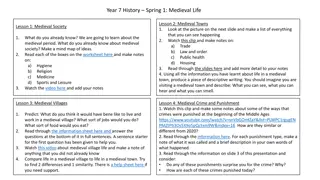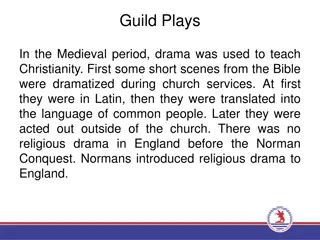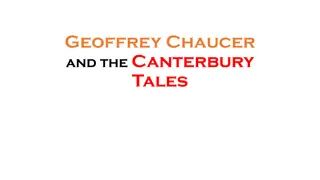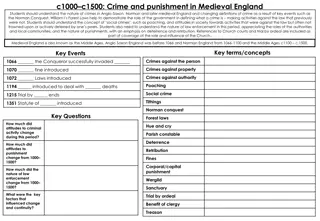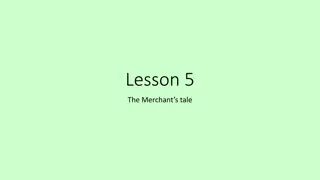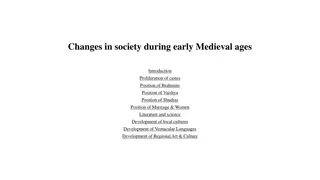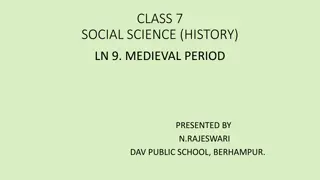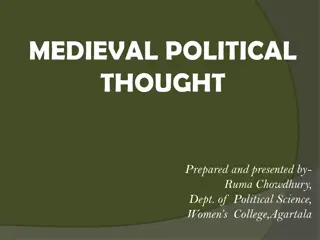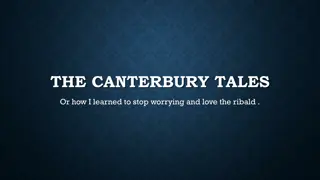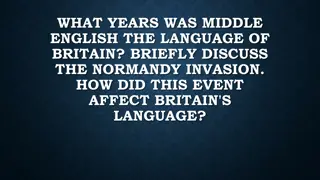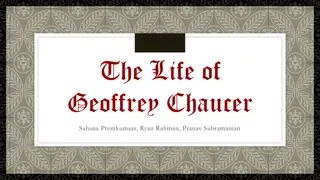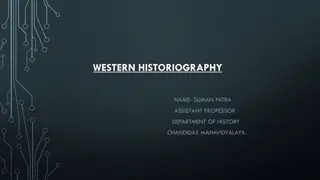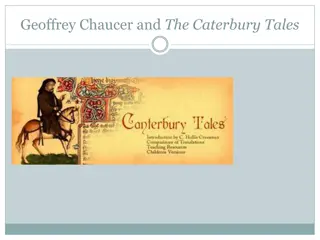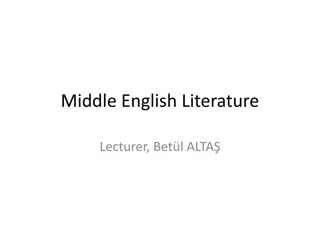Introduction to Geoffrey Chaucer's Medieval Society
Dynamic social structure of medieval England through the lens of Geoffrey Chaucer's life and times. Discover the impact of key historical events such as the Black Death and the Peasants' Revolt on society and individuals. Dive into the intriguing relationships, political upheavals, and societal norms of the 14th century.
Uploaded on Feb 20, 2025 | 3 Views
Download Presentation

Please find below an Image/Link to download the presentation.
The content on the website is provided AS IS for your information and personal use only. It may not be sold, licensed, or shared on other websites without obtaining consent from the author.If you encounter any issues during the download, it is possible that the publisher has removed the file from their server.
You are allowed to download the files provided on this website for personal or commercial use, subject to the condition that they are used lawfully. All files are the property of their respective owners.
The content on the website is provided AS IS for your information and personal use only. It may not be sold, licensed, or shared on other websites without obtaining consent from the author.
E N D
Presentation Transcript
HomeButton.png The Merchant s Tale: An Introduction to Geoffrey Chaucer Thursday, 20 February 2025 Jonathan Peel 2015 JLS
HomeButton.png Dates Born 1340-1345 Edward III dies : Accession of Richard II Died 25/10/1400 Loses job. Eventually appointed JP in Kent 1385 Military service for Edward III including ransom 1360 1385-1400 writing Canterbury Tales Journeys abroad on King s service 1367 77 1399 Henry IV takes throne and confirms Chaucer s various grants. Appointed controller of Wool Custom 1374 Jonathan Peel 2015 JLS
HomeButton.png Society of the day Pope King Cardinals Nobles Archbishops Professions Bishops trades Other church ranks peasants Parish priests Jonathan Peel 2015 JLS
HomeButton.png Medieval Society Ranks decided by birth and by patronage. Generally one stayed in birth position unless entering the church. 3 ESTATES : Prayer, Fighters, Supporters Church and civil society are kept apart. Best seen in 1170 in the death of Thomas Beckett and his relationship with King Henry II Men also are held as far greater worth than women Jonathan Peel 2015 JLS
HomeButton.png Medieval Society post 1349 After the BLACK DEATH there are changes. C.40% of the population of England were killed Scope for enterprise grew as gaps opened in the job markets Much empty housing and vacant businesses. Jonathan Peel 2015 JLS
HomeButton.png A time of upheaval and revolution 1381 Peasants Revolt. Starting in Kent and entering London to complain about high handed treatment of the poor and high taxation. Jack Cade was met by young King and killed in subsequent fighting. One major target was John of Gaunt http://www.englishmonarchs.co.uk/plantagenet_34.html By this time Chaucer was living above Aldgate and was Controller of Wool Custom. In charge of the probity of the single largest export from England Chaucer is allied to Gaunt via his marriage (see later slide) 1399 Henry IV seizes throne from Richard II. Chaucer is caught in middle he supports his King, but H.IV is half brother of his nephew, conceived out of wedlock by Katherine (wife s sister) and John of Gaunt. Jonathan Peel 2015 JLS
HomeButton.png The Family Chaucer married Philippa de Roet: Daughter of a Knight, favoured by Edward III. She outranks the Merchant s son. They marry young (20s) possibly suggesting happiness. Edward favours them both. Her sister Katherine enters service of John Of Gaunt as governess of his daughters when their mother died. She begins an affair which will produce 4 illegitimate offspring and eventually lead to marriage with Gaunt in 1396. Philippa might also catch Gaunt s eye. Certainly she and Chaucer are estranged and by 1370s she is rarely with him and often found at Gaunt s court. Given the hostility between Richard II and Gaunt, Chaucer is playing both sides effectively until Gaunt s death and his removal from office. Jonathan Peel 2015 JLS
HomeButton.png O Fortuna The wheel of fortune was a widely held Medieval conceit and posited a continual alteration in the relative fortunes of all men Jonathan Peel 2015 JLS
HomeButton.png Poetry of Reversal of fortune Many see Canterbury tales in this light. You should, at least, browse a few tales to help to shed light on the Merchant. Knight, Pardoner, Wife of Bath, Miller, General Prologue are musts We see fortune shift time and again Also see criticism of Marriage Jonathan Peel 2015 JLS
HomeButton.png Marriage In several tales, marriage is far from a blissful estate. The Wife of Bath reverses all contemporary expectation by using marriage for her own ends and spitting out husbands along the way The Knights will fight to the death over love In many of the FABLIAUX*, wives are unfaithful and husbands suffer humiliation *: A fabliau is A French humorous, short story of base degree, usually revolving around the lower classes and usually focused on matters of sex and scandal. More later Jonathan Peel 2015 JLS
HomeButton.png Chaucer and Marriage No evidence that Chaucer is not happily married Circumstantial evidence in plenty Kept apart from his wife even after his fall from favour. Bought off by gifts by Gaunt? Living at a time of social and regal upheaval. No surprise if this emerges in the poems. Jonathan Peel 2015 JLS




